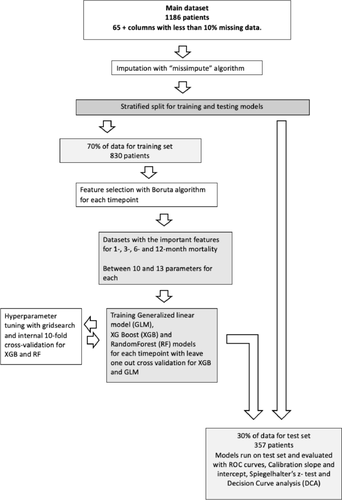Calcified Tissue International ( IF 4.2 ) Pub Date : 2024-04-16 , DOI: 10.1007/s00223-024-01208-1 Mathias Mosfeldt , Henrik Løvendahl Jørgensen , Jes Bruun Lauritzen , Karl-Åke Jansson

|
In order to estimate the likelihood of 1, 3, 6 and 12 month mortality in patients with hip fractures, we applied a variety of machine learning methods using readily available, preoperative data. We used prospectively collected data from a single university hospital in Copenhagen, Denmark for consecutive patients with hip fractures, aged 60 years and older, treated between September 2008 to September 2010 (n = 1186). Preoperative biochemical and anamnestic data were used as predictors and outcome was survival at 1, 3, 6 and 12 months after the fracture. After feature selection for each timepoint a stratified split was done (70/30) before training and validating Random Forest models, extreme gradient boosting (XGB) and Generalized Linear Models. We evaluated and compared each model using receiver operator characteristic (ROC), calibration slope and intercept, Spiegelhalter’s z- test and Decision Curve Analysis. Using combinations of between 10 and 13 anamnestic and biochemical parameters we were able to successfully estimate the likelihood of mortality with an area under the curve on ROC curves of 0.79, 0.80, 0.79 and 0.81 for 1, 3, 6 and 12 month, respectively. The XGB was the overall best calibrated and most promising model. The XGB model most successfully estimated the likelihood of mortality postoperatively. An easy-to-use model could be helpful in perioperative decisions concerning level of care, focused research and information to patients. External validation is necessary before widespread use and is currently underway, an online tool has been developed for educational/experimental purposes (https://hipfx.shinyapps.io/hipfx/).
中文翻译:

利用机器学习技术开发髋部骨折后死亡率的多变量预测模型并进行内部验证
为了估计髋部骨折患者 1、3、6 和 12 个月死亡率的可能性,我们利用现有的术前数据应用了各种机器学习方法。我们前瞻性地收集了丹麦哥本哈根一家大学医院 2008 年 9 月至 2010 年 9 月期间接受治疗的 60 岁及以上连续髋部骨折患者的数据 ( n = 1186)。术前生化和记忆数据用作预测因子,结果是骨折后 1、3、6 和 12 个月的生存率。在为每个时间点选择特征后,在训练和验证随机森林模型、极限梯度提升 (XGB) 和广义线性模型之前进行分层分割 (70/30)。我们使用接收者操作特征 (ROC)、校准斜率和截距、Spiegelhalter 的 z 检验和决策曲线分析来评估和比较每个模型。通过结合 10 到 13 个记忆和生化参数,我们能够成功估计 1、3、6 和 12 个月的死亡率可能性,ROC 曲线下面积分别为 0.79、0.80、0.79 和 0.81。 XGB 是总体上校准最好、最有前途的型号。 XGB 模型最成功地估计了术后死亡的可能性。易于使用的模型可能有助于围手术期做出有关护理水平、重点研究和向患者提供信息的决策。在广泛使用之前,外部验证是必要的,目前正在进行中,已经开发了一个用于教育/实验目的的在线工具(https://hipfx.shinyapps.io/hipfx/)。



























 京公网安备 11010802027423号
京公网安备 11010802027423号